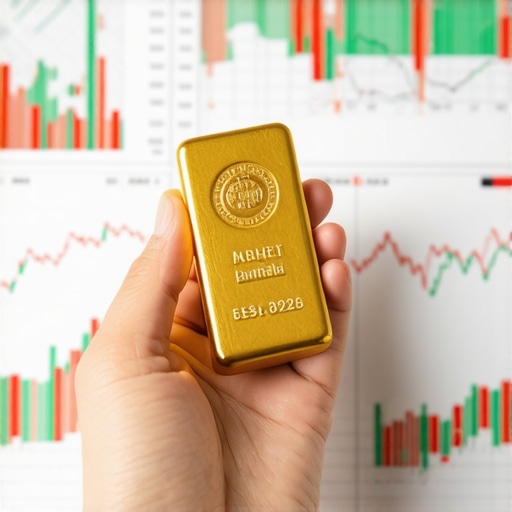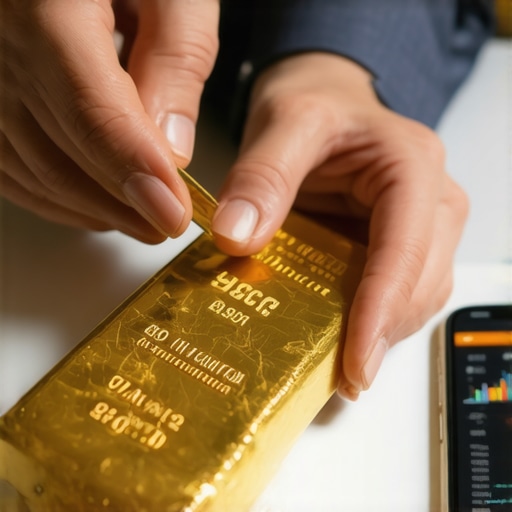Unlocking the Power of Gold IRAs: A Strategic Approach to Retirement Security
In an era marked by economic uncertainty and fluctuating markets, securing a stable and resilient retirement portfolio is paramount. Gold Individual Retirement Accounts (IRAs) have emerged as a compelling alternative to traditional retirement investments, offering unique benefits that blend physical asset security with tax advantages. This article delves deeply into the multifaceted benefits of Gold IRAs and explores how they can be expertly integrated into a retirement strategy designed for long-term safety and growth.
Why Gold IRAs Shine: Beyond the Traditional Portfolio
Gold IRAs allow investors to hold physical gold within their retirement accounts, distinguishing them from conventional IRAs that typically comprise stocks, bonds, or mutual funds. This tangible asset acts as a safeguard against inflation, currency devaluation, and market volatility. Historically, gold has maintained purchasing power even during economic downturns, making it a prudent hedge. Understanding these intrinsic qualities is essential for anyone aiming to build a resilient retirement portfolio.
How Does a Gold IRA Provide a Safety Net During Market Turbulence?
During periods of economic instability, stock markets often experience sharp declines, eroding portfolio values. Gold, conversely, tends to rise in value or remain stable, offering a counterbalance. For instance, during the 2008 financial crisis, gold prices surged as investors sought refuge from collapsing equities. This counter-cyclical behavior can dampen overall portfolio risk and volatility, ensuring that retirement savings are better protected against unforeseen shocks.
Crafting a Balanced Retirement Portfolio: Integrating Gold with Other Assets
Incorporating gold through a Gold IRA should not be viewed as a standalone solution but rather as a strategic component within a diversified portfolio. Allocating between 5% to 15% of retirement assets to gold can optimize risk-adjusted returns. This balance leverages the defensive qualities of gold while maintaining exposure to growth-oriented investments like stocks and bonds. Such diversification is a cornerstone of modern portfolio theory, enhancing resilience and smoothing returns over time.
Tax Advantages and Regulatory Insights: Navigating the Gold IRA Landscape
Gold IRAs offer tax-deferred growth similar to traditional IRAs, with the added benefit of holding IRS-approved precious metals, including gold coins and bars that meet specified purity standards. Additionally, investors can roll over existing retirement accounts into a Gold IRA without penalties, preserving tax advantages while gaining asset diversification. However, compliance with IRS rules regarding storage and custodian selection is critical to maintain the account’s tax-advantaged status.
What Practical Steps Should Investors Take to Build a Safe Gold IRA Portfolio?
Establishing a Gold IRA involves selecting a reputable custodian and choosing IRS-approved gold products. Due diligence in selecting dealers and storage facilities is vital to avoid fraud and ensure asset security. Investors must also consider liquidity needs, fees, and the balance between physical gold and other retirement assets. Engaging with professional financial advisors knowledgeable in precious metals can provide tailored strategies aligned with individual risk tolerance and retirement goals.
For those seeking an authoritative and comprehensive resource on this topic, the Ultimate Guide to Gold IRA Benefits and Investment Options offers detailed insights and practical advice from industry experts.
If you found these insights valuable, consider sharing this article with others planning their retirement or leave a comment below to share your experiences with Gold IRAs.
Mitigating Risks in Gold IRA Investments: Beyond Basic Diversification
While gold IRAs inherently provide a hedge against inflation and market volatility, advanced investors recognize the importance of managing specific risks associated with precious metals holdings. For example, price fluctuations in the gold market can be influenced by geopolitical tensions, currency strength, and central bank policies. Incorporating tactical rebalancing strategies can help maintain optimal asset allocation within a Gold IRA, ensuring the portfolio remains aligned with evolving market conditions and retirement goals.
Storage Solutions and Their Impact on Gold IRA Security and Costs
Choosing the correct storage option is critical in preserving both the security and the tax-advantaged status of a Gold IRA. IRS regulations mandate that physical gold must be stored in an approved depository rather than in personal possession, which introduces considerations around security, insurance, and fees. Some custodians offer segregated storage, where your gold is stored separately from other investors’ holdings, providing enhanced security but at a potentially higher cost. Understanding these nuances assists investors in making informed decisions balancing risk, accessibility, and expense.
How Can Investors Effectively Navigate the Complexities of Gold IRA Custodianship?
Selecting a custodian is a pivotal decision that impacts the safety, liquidity, and compliance of your Gold IRA. Investors should evaluate custodians based on their experience with precious metals IRAs, fee transparency, customer service, and depository partnerships. Additionally, reviewing independent ratings and testimonials can provide insights into custodian reliability. Engaging a custodian with robust expertise in gold IRAs ensures a smoother rollover process and ongoing portfolio management, reducing operational risks.
According to the Investopedia guide on gold IRAs, understanding the custodian’s role is fundamental to maximizing the benefits of precious metals investments within retirement accounts. Their detailed analysis emphasizes due diligence and regulatory compliance as keys to successful Gold IRA management.
Leveraging Gold Stocks and ETFs as Complementary Gold IRA Investments
While physical gold provides tangible asset security, integrating gold mining stocks and gold ETFs within a broader retirement plan can offer liquidity and growth potential. These instruments respond differently to market dynamics compared to physical gold, often amplifying price movements due to operational leverage in mining companies or fund management strategies. For investors seeking diversified exposure without the complexities of physical storage, allocating a portion of retirement assets to these securities can enhance portfolio flexibility.
For further exploration of how to balance physical gold with gold stocks and ETFs, readers are encouraged to review the Beginners Guide to Gold Stocks: Risks and Rewards Explained, which provides comprehensive insights into integrating these assets effectively.
We invite you to share your thoughts or questions about Gold IRA strategies in the comments section below, and feel free to share this article with fellow investors seeking to strengthen their retirement planning.
Advanced Risk Mitigation Techniques: Tactical Rebalancing and Market Signal Integration
Beyond basic diversification, seasoned investors employ sophisticated risk management strategies to optimize their Gold IRA performance. One such approach involves tactical rebalancing, which requires periodic portfolio adjustments based on market signals rather than fixed intervals. By monitoring indicators like real interest rates, geopolitical risk indices, and currency strength, investors can decide when to increase or decrease gold allocations to maximize risk-adjusted returns. This proactive strategy helps mitigate exposure during periods of gold price stagnation or decline while capitalizing on bullish trends.
Moreover, integrating quantitative analytics such as volatility forecasting and correlation matrices between gold, equities, and bonds enables a dynamic understanding of portfolio interdependencies. This insight facilitates the construction of resilient portfolios that adapt swiftly to macroeconomic shifts.
Nuances in Gold IRA Custodian Selection: Beyond Fees and Reputation
Choosing a custodian for a Gold IRA extends well beyond evaluating fees and general reputation. Expert investors scrutinize the custodian’s operational protocols, including their compliance audit frequency, segregation practices, and insurance policies covering physical assets. For instance, custodians offering segregated storage ensure that your gold bars or coins are individually identified and separated from other clients’ holdings, a crucial factor in asset security and liquidity.
Additionally, the custodian’s technological infrastructure—such as digital asset tracking and real-time reporting—can significantly enhance transparency and investor confidence. Engaging custodians who provide comprehensive educational resources and dedicated account managers further supports informed decision-making and swift resolution of complex issues.
What Are the Most Critical Compliance and Security Considerations When Selecting a Gold IRA Custodian?
Ensuring the custodian adheres strictly to IRS regulations on precious metals storage is paramount. This includes using IRS-approved depositories and maintaining asset segregation. Beyond regulatory compliance, investors should verify that custodians have robust anti-fraud mechanisms and transparent fee disclosures to avoid hidden costs. It’s also essential to assess the custodian’s track record for timely and accurate asset appraisal reports, which are vital for portfolio valuation and tax reporting.
According to the U.S. Securities and Exchange Commission’s Gold IRA Investor Alert, due diligence in custodian selection is critical to safeguarding retirement assets, emphasizing verification of licensing, insurance, and compliance history.
Integrating Digital Innovations: Blockchain and Tokenization in Gold IRA Management
Emerging technologies such as blockchain offer transformative potential for Gold IRA custodianship. Tokenization of physical gold assets enables fractional ownership and enhanced liquidity while preserving the tangible asset backing. This innovation can streamline transaction settlement, reduce counterparty risks, and provide immutable audit trails enhancing transparency.
While regulatory frameworks are still evolving around these digital assets, early adoption by forward-thinking custodians may soon redefine the operational landscape of Gold IRAs. Investors interested in pioneering these advancements should consult with specialized advisors to navigate the complex intersection of technology, regulation, and traditional precious metals investing.

Strategic Allocation Models: Balancing Physical Gold with Gold-Related Financial Instruments
Expert portfolio architects recognize the benefits of blending physical gold holdings with gold equities and ETFs to capture diverse market exposures. Gold mining stocks, for example, provide leveraged exposure to gold price movements but introduce company-specific risks such as operational disruptions and management decisions. Gold ETFs offer liquidity and ease of trading but may not provide the same inflation hedge as physical bullion.
Optimal allocation depends on individual risk tolerance, investment horizon, and retirement objectives. Multi-asset models can incorporate physical gold for stability, mining stocks for growth potential, and ETFs for tactical rebalancing. Advanced investors may also explore derivative instruments for hedging purposes, although these require sophisticated understanding and are generally unsuitable for novice investors.
For a deeper dive into sophisticated allocation strategies combining these asset classes, we recommend consulting specialized literature and engaging with financial professionals experienced in precious metals portfolio construction.
Engage with this content by sharing your questions or unique strategies in managing Gold IRAs below. Your insights contribute to a richer community understanding and support fellow investors in navigating this complex asset class.
Harnessing Behavioral Finance Insights to Optimize Gold IRA Decisions
Investors often grapple with cognitive biases that can inadvertently undermine their Gold IRA strategies. Recognizing phenomena such as loss aversion, overconfidence, and anchoring bias is crucial for maintaining disciplined, long-term investment approaches. Behavioral finance research suggests that structured decision frameworks and algorithmic triggers for rebalancing can minimize emotional interference, thereby enhancing portfolio stability and performance in precious metals investing.
Exploring the Intersection of Macroeconomic Indicators and Gold Price Dynamics
Deep understanding of macroeconomic variables—such as real interest rates, inflation expectations, and currency fluctuations—enables investors to anticipate gold price movements more effectively. For example, a sustained negative real interest rate environment typically bolsters gold demand due to its non-yielding nature. Incorporating econometric models that analyze these indicators facilitates dynamic allocation within Gold IRAs, allowing investors to tactically adjust exposure according to evolving economic conditions.
How Can Advanced Analytics Enhance Tactical Allocation Within Gold IRAs?
Advanced analytics—including machine learning algorithms and predictive modeling—are increasingly leveraged to refine Gold IRA allocation strategies. These tools analyze vast datasets comprising historical price trends, geopolitical events, and macroeconomic metrics to forecast optimal timing and weighting for gold investments. By integrating these data-driven insights, investors can move beyond static allocation models, enabling responsive portfolio adjustments that align with market cycles and risk tolerance.
Regulatory Foresight: Anticipating Policy Shifts Impacting Gold IRAs
Staying abreast of impending regulatory changes is indispensable for safeguarding Gold IRA assets. Emerging legislative trends around precious metals taxation, securities laws, and digital asset integration can materially affect investment vehicles and custodial practices. Engaging with legal experts specializing in retirement and commodities law ensures proactive compliance and strategic positioning ahead of policy shifts.
Collaborative Networks and Expert Forums: Elevating Investor Competence
Participation in specialized investor communities and professional forums focused on precious metals elevates knowledge exchange and exposure to cutting-edge strategies. Such networks often provide early insights into custodian innovations, storage solutions, and market intelligence. Leveraging these collaborative platforms facilitates peer benchmarking and access to bespoke advisory services that enhance Gold IRA management.
What Emerging Technologies Are Poised to Revolutionize Gold IRA Security and Transparency?
Blockchain and distributed ledger technologies stand at the forefront of transforming Gold IRA custodianship by enabling immutable transaction records and enhanced asset provenance verification. Smart contracts can automate compliance checks and facilitate instant settlement of gold transactions, mitigating counterparty risks. Additionally, integrating Internet of Things (IoT) devices within storage facilities offers real-time environmental monitoring, further safeguarding physical assets.
According to a detailed report by the World Gold Council, these innovations promise to enhance transparency, reduce operational costs, and improve investor confidence in gold-backed retirement vehicles.
We encourage you to delve into these advanced insights and share your experiences or inquiries about integrating innovative strategies within your Gold IRA portfolio in the comments below. Engage with our community of experts to refine your retirement planning for a resilient future.
Frequently Asked Questions (FAQ)
What exactly is a Gold IRA and how does it differ from a traditional IRA?
A Gold IRA is a self-directed Individual Retirement Account that allows investors to hold physical gold or other IRS-approved precious metals as part of their retirement portfolio. Unlike traditional IRAs, which typically hold stocks, bonds, or mutual funds, Gold IRAs provide direct exposure to tangible assets, offering a hedge against inflation and market volatility.
How much of my retirement portfolio should ideally be allocated to gold?
Experts generally recommend allocating between 5% to 15% of your retirement assets to gold. This range balances the defensive benefits of physical gold with growth opportunities from equities and bonds, optimizing risk-adjusted returns and portfolio diversification.
What are the key IRS regulations and requirements for Gold IRAs?
The IRS mandates that physical gold held in IRAs must meet minimum purity standards and be stored in approved depositories, not personal possession. Custodians must comply with strict reporting, storage, and segregation rules to maintain the tax-advantaged status of the account.
How do I choose a trustworthy custodian for my Gold IRA?
Look for custodians with extensive experience in precious metals IRAs, transparent fee structures, strong compliance records, segregated storage options, and positive independent reviews. Robust anti-fraud policies and real-time asset tracking capabilities are also essential for security and peace of mind.
Can I include gold mining stocks or ETFs in my Gold IRA?
Yes, many Gold IRAs allow investments in gold mining stocks and gold ETFs, which provide liquidity and growth potential. However, these instruments carry different risks than physical gold, including company-specific and market-related volatility, so they are best used as complementary assets within a diversified portfolio.
What advanced strategies can optimize Gold IRA performance?
Advanced investors employ tactical rebalancing based on market signals, integrate quantitative analytics like volatility forecasts, and use behavioral finance principles to avoid emotional biases. These approaches enable dynamic portfolio adjustments that align with changing economic conditions and enhance risk management.
How does blockchain technology impact Gold IRA management?
Blockchain enables tokenization of physical gold, creating fractional ownership and improving liquidity while maintaining asset backing. It also enhances transparency through immutable audit trails and can automate compliance processes via smart contracts, potentially revolutionizing Gold IRA custodianship.
What risks should investors be aware of when investing in Gold IRAs?
Risks include gold price volatility influenced by geopolitical events and currency fluctuations, custodian fraud or mismanagement, storage and insurance costs, and regulatory changes. Conducting comprehensive due diligence and employing advanced risk mitigation strategies is critical to safeguarding investments.
Are there tax implications when rolling over existing retirement accounts into a Gold IRA?
Rolling over existing IRAs or 401(k) plans into a Gold IRA can be done without immediate tax penalties if executed properly as a direct rollover. However, failure to comply with IRS rollover deadlines or improper handling can trigger taxes and penalties, so professional guidance is recommended.
How do macroeconomic factors influence gold prices and Gold IRA strategies?
Gold prices are sensitive to real interest rates, inflation expectations, currency strength, and geopolitical risks. Understanding these indicators helps investors time tactical allocations within Gold IRAs, enhancing the portfolio’s ability to hedge against economic uncertainties.
Trusted External Sources
- World Gold Council: As the authority on gold market research, it provides comprehensive data on gold price dynamics, investment trends, and technological innovations impacting precious metals investing.
- U.S. Securities and Exchange Commission (SEC): Offers investor alerts and regulatory guidance specifically addressing Gold IRAs and custodian compliance, essential for safeguarding retirement assets.
- Investopedia: Features expert-curated, detailed guides on Gold IRAs, including custodian selection, tax implications, and investment strategies, making it a valuable educational resource.
- BuyingGoldNow.com: Provides in-depth articles and practical advice on gold IRA benefits, investment options, and integrating gold stocks and ETFs, helping investors make informed decisions.
- National Association of Personal Financial Advisors (NAPFA): Offers access to fiduciary financial advisors experienced in precious metals investing and retirement planning, facilitating personalized strategy development.
Conclusion
Gold IRAs represent a sophisticated yet accessible vehicle for enhancing retirement portfolio resilience through tangible asset diversification. By blending physical gold with complementary financial instruments such as gold stocks and ETFs, investors can optimize growth potential while mitigating risks associated with market volatility and inflation. Success in Gold IRA investing hinges on meticulous custodian selection, adherence to IRS regulations, and the application of advanced strategies including tactical rebalancing and behavioral finance insights. Emerging technologies like blockchain promise to further transform custodianship, enhancing security and transparency. Armed with this expert knowledge, investors can confidently integrate Gold IRAs into their retirement plans, ensuring a robust and adaptive foundation for long-term financial security. We encourage you to apply these insights, share your perspectives, and continue exploring specialized content to refine your retirement strategy for a prosperous future.











What really struck me about Gold IRAs is how they serve as a safeguard during economic instability, especially given recent market volatility. The article’s explanation about how gold often rises or remains stable when traditional stocks dip sheds light on why it’s a smart addition to a retirement portfolio. I personally started diversifying into a Gold IRA a few years back after experiencing losses in equities during sudden downturns. While the allocation of 5% to 15% seems reasonable, I’ve found adjusting that percentage occasionally based on geopolitical events and inflation trends beneficial. One area that can be tricky, though, is selecting a trustworthy custodian. The emphasis on transparent fee structures and segregated storage options is something I wish I’d known earlier, as initial research mainly focused on returns and less on storage security. For those balancing physical gold with gold stocks and ETFs, how do you weigh liquidity against long-term stability? Also, with blockchain and tokenization entering the picture, do others foresee these technologies becoming standard in Gold IRA management soon, or is it still too early to embrace them fully? I’d be really interested to hear experiences or strategies from others navigating these nuances.